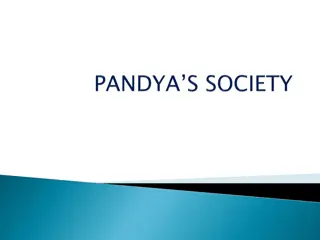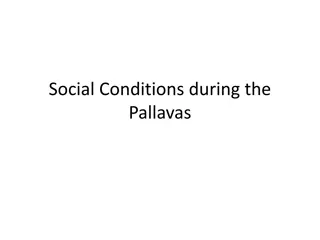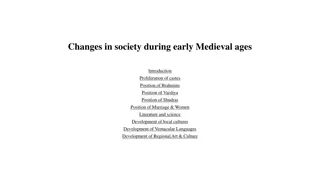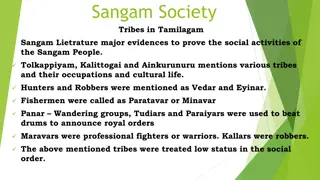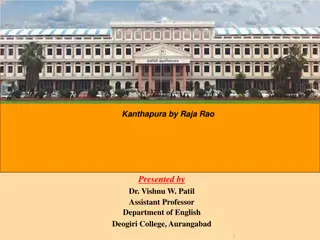Social Structure and Privileges in the Pandya Kingdom
The social conditions in the Chola and Pandya periods saw the Brahmins holding a significant position, with rulers granting them land and privileges. The Vellalas were the farmers, known as sons of the soil, and had roles in the court and army. Cowherds were respected and religious, while the mercha
1 views • 11 slides
Social Structure and Life During the Pallava Rule
The Pallava rule brought significant changes in social and economic life, with a structured society divided into Brahmins, Kshatriyas, Vaisyas, and Sudras. Brahmins held a high position, while Kshatriyas were warriors and contributors to societal development. Vaisyas were involved in agriculture and
0 views • 6 slides
Social Changes in Early Medieval India: Caste Proliferation and Hierarchies
Social changes during the early Medieval ages in India were shaped by economic developments, leading to the proliferation of castes and shifts in the positions of Brahmins, Vaishyas, and Shudras. The Brahmins held the highest social position, while Vaishyas were marginalized. The period also saw the
0 views • 11 slides
Social Structure and Cultural Life in Sangam Society
Sangam literature provides insights into the social activities of Sangam people, showcasing various tribes, occupations, and cultural practices. Brahmins held a supreme position, while women were not treated equally. Different tribes had specific roles, such as Maravars as warriors and Kallars as ro
0 views • 11 slides
Social Structure and Cultural Life in Sangam Society
Sangam literature provides insight into the social structure and cultural life of the Sangam people in Tamilagam. The tribes, occupations, and status of various groups such as the Brahmins, Vaisiyas, and artisans are highlighted. Despite the prevalence of arranged marriages and unequal treatment of
0 views • 11 slides
Raja Rao's Kanthapura: A Tale of Tradition and Transformation
Raja Rao's novel "Kanthapura" narrates the story of a village in South India through the eyes of an old woman, Achakka. The village is divided by caste, with Brahmins holding privilege. The protagonist, Moorthy, embraces Gandhian ideals and challenges the caste system, facing excommunication. The no
0 views • 19 slides
